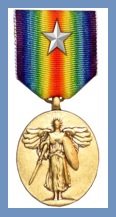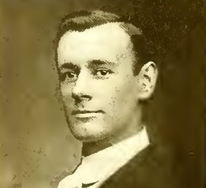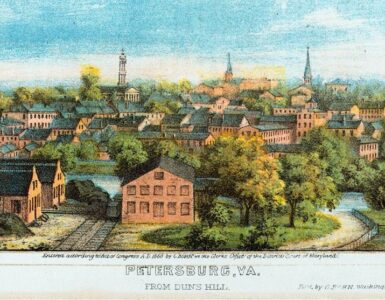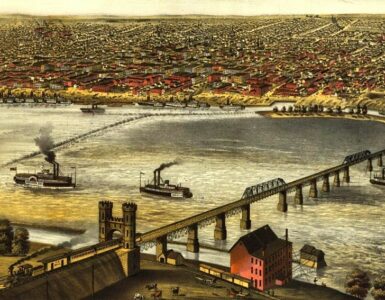John Wesley was born February 1, 1885 to Jacob and Elizabeth Roth Ischy in their home just across the Ohio River from West Virginia in Hannibal, Ohio. Both Jacob and Elizabeth were immigrants from German-speaking Bern, Switzerland. The selection of the name “John Wesley” may indicate the desire of his Swiss parents to ease his acceptance in their new English-speaking homeland. Based on the sources available it cannot be said for certain, but it is likely that as young John Wesley learned English he also absorbed his ancestral German during childhood.
John graduated Lebanon Valley College in Annville, Pennsylvania, 1912. The college had been founded by the United Brethren Church in 1865 with classes beginning the following year. John was actively involved in several campus organizations and activities, especially those concerned with literary or oratory subjects. He was the class poet, performed in campus plays, and worked on the college yearbook, The Bizarre. As was common on campuses of the day, the Young Men’s Christian Association (YMCA) had a Lebanon Valley College chapter with Ischy serving in one of its administrative offices. Because of the similarity of the sound of his surname to that of the word achoo, he was sometimes teased in student publications in association with subjects related to sneezing, pepper, etc. During his college years he attended the Salem German Evangelical Lutheran Church in nearby Lebanon.
In the fall of 1912 graduate John entered Princeton Seminary to prepare for the ministry. Theology apparently did not keep him busy enough because he studied for and received the Master of Arts from Princeton University in 1914. The next calendar year was an eventful one for the seminarian because he completed his divinity program, married Mary LaVerne Keisher on September 3rd in Scottdale, Pennsylvania, was ordained by Carlisle Presbytery of the Presbyterian Church in the United States of America (PCUSA), and moved with his bride to North Dakota.
 After a brief ministry in Werner, North Dakota–a town which no longer exists, the Ischy household moved roughly 300 miles east-south-east to Lisbon so Rev. Ischy could supply its Presbyterian Church. His service in the American prairie did not last very long because after the United States entered The Great War in April 1917, he left his church to become a chaplain for the PCUSA. The several denominations in the country were allotted chaplains according to the size of their memberships with the PCUSA having a total of about two hundred in ministry by the end of the war. He first served in combat during the United States led offensive at Saint-Mihiel in September 1918, and then Chaplain Ischy continued his service at the front in the Battles of the Meuse-Argonne until the end of the war. He was near Romagne-sous-Montfaucon with the 38th Infantry Regiment, 3rd Division, when during heavy shelling he endangered himself to remove wounded soldiers from no man’s land for medical treatment. For his valor Chaplain Ischy was awarded the Citation Star, which was silver and affixed to the ribbon of his Victory Medal. The Citation Star was established by Presbyterian President Woodrow Wilson in July 1918 and in later years it became what is currently the Silver Star, the third highest medal awarded for courageous military service. Chaplain Ischy was honored for his heroism saving those who had been wounded by the German military, the members of an army that spoke his ancestral language. When the war ended on November 11, 1918, Ischy continued his chaplaincy into 1920 serving with the Army of Occupation.
After a brief ministry in Werner, North Dakota–a town which no longer exists, the Ischy household moved roughly 300 miles east-south-east to Lisbon so Rev. Ischy could supply its Presbyterian Church. His service in the American prairie did not last very long because after the United States entered The Great War in April 1917, he left his church to become a chaplain for the PCUSA. The several denominations in the country were allotted chaplains according to the size of their memberships with the PCUSA having a total of about two hundred in ministry by the end of the war. He first served in combat during the United States led offensive at Saint-Mihiel in September 1918, and then Chaplain Ischy continued his service at the front in the Battles of the Meuse-Argonne until the end of the war. He was near Romagne-sous-Montfaucon with the 38th Infantry Regiment, 3rd Division, when during heavy shelling he endangered himself to remove wounded soldiers from no man’s land for medical treatment. For his valor Chaplain Ischy was awarded the Citation Star, which was silver and affixed to the ribbon of his Victory Medal. The Citation Star was established by Presbyterian President Woodrow Wilson in July 1918 and in later years it became what is currently the Silver Star, the third highest medal awarded for courageous military service. Chaplain Ischy was honored for his heroism saving those who had been wounded by the German military, the members of an army that spoke his ancestral language. When the war ended on November 11, 1918, Ischy continued his chaplaincy into 1920 serving with the Army of Occupation.
 When John Ischy left the military and returned to the United States from France he was briefly a stated supply for Stubenville Presbytery, Synod of Ohio, PCUSA, and then for a few years he served the Dell Roy and New Harrisburg congregations in the same presbytery. Due to poor health, which he said in some unspecified way was a result of his war service, he could not continue in full-time ministry. The family moved to Florida in 1923 where he transferred his ministerial credentials to the Presbyterian Church in the United States (PCUS), St. John’s Presbytery. It is speculative, but it may be that Ischy suffered lung damage from a chemical attack during the war and he hoped the more consistently warm air of Florida would alleviate breathing difficulties. Rev. Ischy often labored outside the bounds of presbytery supplying the Windermere Union Church, an independent church in Gotha near Orlando. In 1932 he became its minister and continued as such until his retirement in 1947. Gotha had been founded in the 1880s by a wealthy German inventor from New York named Henry Hempel and it developed as a community of German immigrants.
When John Ischy left the military and returned to the United States from France he was briefly a stated supply for Stubenville Presbytery, Synod of Ohio, PCUSA, and then for a few years he served the Dell Roy and New Harrisburg congregations in the same presbytery. Due to poor health, which he said in some unspecified way was a result of his war service, he could not continue in full-time ministry. The family moved to Florida in 1923 where he transferred his ministerial credentials to the Presbyterian Church in the United States (PCUS), St. John’s Presbytery. It is speculative, but it may be that Ischy suffered lung damage from a chemical attack during the war and he hoped the more consistently warm air of Florida would alleviate breathing difficulties. Rev. Ischy often labored outside the bounds of presbytery supplying the Windermere Union Church, an independent church in Gotha near Orlando. In 1932 he became its minister and continued as such until his retirement in 1947. Gotha had been founded in the 1880s by a wealthy German inventor from New York named Henry Hempel and it developed as a community of German immigrants.
When Pastor Emeritus Ischy’s Princeton Seminary class held its fiftieth reunion in 1955 he was unable to attend, but he sent a letter from his Florida home on May 15th to his campus colleagues. After greeting his buddies he expressed regret that he could not join them in their time together. Then, he mentioned some events in his life.
I recently celebrated my 80th birthday. The niece and her husband who are living with me, planned a surprise all day open house for the occasion. I had the pleasure of greeting nearly a hundred of my old friends together with some of the new members of our community.…
I am happy to report that I have almost completely recovered from the effects of a severe stroke which I suffered about eighteen months ago. There has been no permanent impairment of any of my faculties, although my voice is such that I cannot take part in the singing of hymns, but I find that there are a number of other ways of praising God! SELAH
The letter is concluded by Princetonian Ischy wishing his classmates “a very happy time at the REUNION.” Pastor and Chaplain John Wesley Ischy passed away on October 7, 1973 at the age of 88. He was buried in Woodlawn Memorial Park in Gotha beside Laverne who predeceased him in 1961.
BARRY WAUGH
Sources include the Military Times website for the image of the medal with a Citation Star; the biographical catalogs of Princeton Seminary; a copy of Ischy’s letter to his seminary colleagues at the reunion, and some details about his life from Ken Henke, Currator of Special Collections and Archivist, Princeton Theological Seminary; Scott’s Ministerial Directory of the PCUS; several publications by Lebanon Valley College including The Bizarre that are available on Internet Archive, one of which included the street-clothes portrait above; general assembly minutes of the PCUSA from 1915-1922; information on the Windermere Union Church was located in the online article by the Orange Observer, “Windermere Union Church Celebrating Century of Blessings,” September 13, 2016; and the image of Ischy in his uniform is from The Continent, vol. 51, no. 10, March 4, 1920. The PDF publication, “Chemical Warfare in World War I: The American Experience, 1917-1918,” number 10, by Major Charles E. Heller, in the Leavenworth Papers series provides an 120-page study of the use of chemical weapons during the First World War. For information on the Salem German Evangelical Lutheran Church in Lebanon, Pennsylvania, see Old Salem in Lebanon: A History of the Congregation and Town, by T. E. Schmauck, 1898, as available digitally on Internet Archive; the church is currently named Salem Lutheran Church.





